The Effect of Air Parameters on the Evaporation Loss in a Natural Draft Counter-Flow Wet Cooling Tower
Abstract
:1. Introduction
2. Mathematical Model
- The conditions of water and air varied only with vertical position in the tower.
- Radiation heat transfer from air to water was negligible.
- Heat transfer through the tower wall to the environment was negligible.
- Temperatures of water and air at any cross-sections were uniform.
- Windage and blowdown losses were negligible.
3. Experimental Verification
4. Results and Discussion
4.1. Relative Air Humidity
4.2. Air-Dry Bulb Temperature
5. Conclusions
Author Contributions
Funding
Conflicts of Interest
Nomenclature
| At | fill surface area of the NDWCT (m2) |
| Av | surface area per unit volume of fill (m2/m3) |
| As | the area of cross section of fill (m2) |
| cp | specific heat at constant pressure (J/kg°C) |
| C, n | constants |
| g | gravitational acceleration (m/s2) |
| hd | mass-transfer coefficient (kg/m2s) |
| Hinlet | tower inlet height (m) |
| Ht | the tower height (m) |
| H | pumping force of NDWCT (Pa) |
| imasw | the enthalpy of the saturated air layer on the water surface when water temperature is Tw (J/kg) |
| ima | the enthalpy of the moist air when air temperature is Ta (J/kg) |
| j | the coordinates of the laps where the measuring point is located |
| Ke | the ratio of evaporation loss to total circulating water at per 1 °C temperature drop (%·1/°C) |
| k | heat coefficient |
| m | mass flow rate (kg/s) |
| mevap | evaporation loss (t/h) |
| ma | mass flow rate of air (kg/s) |
| mw | mass flow rate of circulating water (kg/s) |
| Me | Merkel number |
| NDWCT | natural draft counter-flow wet cooling tower |
| Qc | conduction heat dissipation in NDWCT (W) |
| Qe | evaporation heat dissipation in NDWCT (W) |
| rj | the radius of the measuring point in the lap j (m) |
| R | the radius of collecting basin (m) |
| Tw | water temperature (°C) |
| Tw1 | inlet water temperature of the finite volume(°C) |
| Tw2 | outlet water temperature of the finite volume(°C) |
| Twi | inlet water temperature of NDWCT(°C) |
| Two | outlet water temperature of NDWCT (°C) |
| Ta | air temperature (°C) |
| Tai | inlet air temperature of NDWCT(°C) |
| Tao | outlet air temperature of NDWCT(°C) |
| vam | the average airflow velocity in packing section (m/s) |
| z | height of the finite volume |
| Z | resistance of the NDWCT (Pa) |
Greek Letters
| ξ | total drag coefficient of tower |
| ρai | tower inlet air density (kg/m3) |
| ρao | tower outlet air density (kg/m3) |
| w | humidity ratio of air (kg/kg) |
| ε | the ratio of evaporation heat dissipation to total heat disspation |
| λ | air-water ratio |
| γTw2 | the latent heat of vaporization at the temperature of Tw2 (kJ/kg) |
Subscripts
| a | air |
| c | conduction |
| e | evaporation |
| i | inlet |
| M | modification |
| m | mean, or mass transfer |
| o | outlet |
| s | saturation |
| t | tower |
| w | water |
References
- Feeley, T.J., III; Skone, T.J.; Stiegel, G.J.; McNemar, A.; Nemeth, M.; Schimmoller, B.; Murphy, J.T.; Manfredo, L. Water: A critical resource in the thermoelectric power industry. Energy 2008, 33, 1–11. [Google Scholar] [CrossRef]
- Cutillas, C.G.; Ramírez, J.R.; Lucas, M. Optimum Design and Operation of an HVAC Cooling Tower for Energy and Water Conservation. Energies 2017, 10, 299. [Google Scholar] [CrossRef] [Green Version]
- Macknick, J.; Newmark, R.L.; Heath, G.; Hallett, K.C. Operational water consumption and withdrawal factors for electricity generating technologies: A review of existing literature. Environ. Res. Lett. 2012, 7, 045802. [Google Scholar] [CrossRef]
- Owen, M.T.F.; Kröger, D.G. An Investigation of Air-Cooled Steam Condenser Performance Under Windy Conditions Using Computational Fluid Dynamics. J. Eng. Gas Turbines Power 2011, 133, 064502. [Google Scholar] [CrossRef]
- Yang, L.J.; Du, X.Z.; Yang, Y.P. Influences of wind-break wall configurations upon flow and heat transfer characteristics of air-cooled condensers in a power plant. Int. J. Therm. Sci. 2011, 50, 2050–2061. [Google Scholar] [CrossRef]
- Zhang, L.; Zhang, L.; Zhang, Q.; Jiang, K.; Tie, Y.; Wang, S. Effects of the Second-Stage of Rotor with Single Abnormal Blade Angle on Rotating Stall of a Two-Stage Variable Pitch Axial Fan. Energies 2018, 11, 3293. [Google Scholar] [CrossRef] [Green Version]
- Zhang, L.; He, R.; Wang, X.; Zhang, Q.; Wang, S. Study on static and dynamic characteristics of an axial fan with abnormal blade under rotating stall conditions. Energy 2019, 170, 305–325. [Google Scholar] [CrossRef]
- Meyer, C.J.; Kroger, D.G. Numerical investigation of the effect of fan performance on forced draught air-cooled heat exchanger plenum chamber aerodynamic behaviour. Appl. Therm. Eng. 2004, 24, 359–371. [Google Scholar] [CrossRef]
- Kairouani, L.; Hassairi, M.; Tarek, Z. Performance of cooling tower in south of Tunisia. Build. Environ. 2004, 39, 351–355. [Google Scholar] [CrossRef]
- Xia, L.; Li, J.; Ma, W.; Gurgenci, H.; Guan, Z.; Wang, P. Water Consumption Comparison Between a Natural Draft Wet Cooling Tower and a Natural Draft Hybrid Cooling Tower—An Annual Simulation for Luoyang Conditions. Heat Transf. Eng. 2017, 38, 1034–1043. [Google Scholar] [CrossRef]
- Facao, J.; Oliveira, A.C. Heat and Mass Transfer in an Indirect Contact Cooling Tower: CFD Simulation and Experiment. Numer. Heat Transf. Part A Appl. 2008, 54, 933–944. [Google Scholar] [CrossRef]
- Qureshi, B.A.; Zubair, S.M. Prediction of Evaporation Losses in Wet Cooling Towers. Heat Transf. Eng. 2006, 27, 86–92. [Google Scholar] [CrossRef]
- Qureshi, B.A.; Zubair, S.M. Prediction of evaporation losses in evaporative fluid coolers. Appl. Therm. Eng. 2007, 27, 520–527. [Google Scholar] [CrossRef]
- Hajidavalloo, E.; Shakeri, R.; Mehrabian, M.A. Thermal performance of cross flow cooling towers in variable wet bulb temperature. Energy Convers. Manag. 2010, 51, 1298–1303. [Google Scholar] [CrossRef]
- Rubio-Castro, E.; Serna-González, M.; Ponce-Ortega, J.M.; Morales-Cabrera, M.A. Optimization of mechanical draft counter flow wet-cooling towers using a rigorous model. Appl. Therm. Eng. 2011, 31, 3615–3628. [Google Scholar] [CrossRef]
- Rao, R.V.; More, K.C. Optimal design and analysis of mechanical draft cooling tower using improved Jaya algorithm. Int. J. Refrig. 2017, 82, 312–324. [Google Scholar] [CrossRef]
- Naik, B.K.; Muthukumar, P. A novel approach for performance assessment of mechanical draft wet cooling towers. Appl. Therm. Eng. 2017, 121, 14–26. [Google Scholar] [CrossRef]
- Mansour, M.K.; Hassab, M.A. Innovative correlation for calculating thermal performance of counterflow wet-cooling tower. Energy 2014, 74, 855–862. [Google Scholar] [CrossRef]
- Picardo, J.R.; Variyar, J.E. The Merkel equation revisited: A novel method to compute the packed height of a cooling tower. Energy Convers. Manag. 2012, 57, 167–172. [Google Scholar] [CrossRef]
- Fisenko, S.P.; Brin, A.A.; Petruchik, A.I. Evaporative cooling of water in a mechanical draft cooling tower. Int. J. Heat Mass Transf. 2004, 47, 165–177. [Google Scholar] [CrossRef]
- Chen, C.J.; Wang, R.Z.; Xia, Z.Z.; Kiplagat, J.K. Study on a silica gel–water adsorption chiller integrated with a closed wet cooling tower. Int. J. Therm. Sci. 2010, 49, 611–620. [Google Scholar] [CrossRef]
- Gao, M.; Zou, J.; He, S.; Sun, F. Thermal performance analysis for high level water collecting wet cooling tower under crosswind conditions. Appl. Therm. Eng. 2018, 136, 568–575. [Google Scholar] [CrossRef]
- Zhao, Z. Cooling Tower; Chinese Water Conservancy and Electric Power Publisher: Beijing, China, 2001. [Google Scholar]
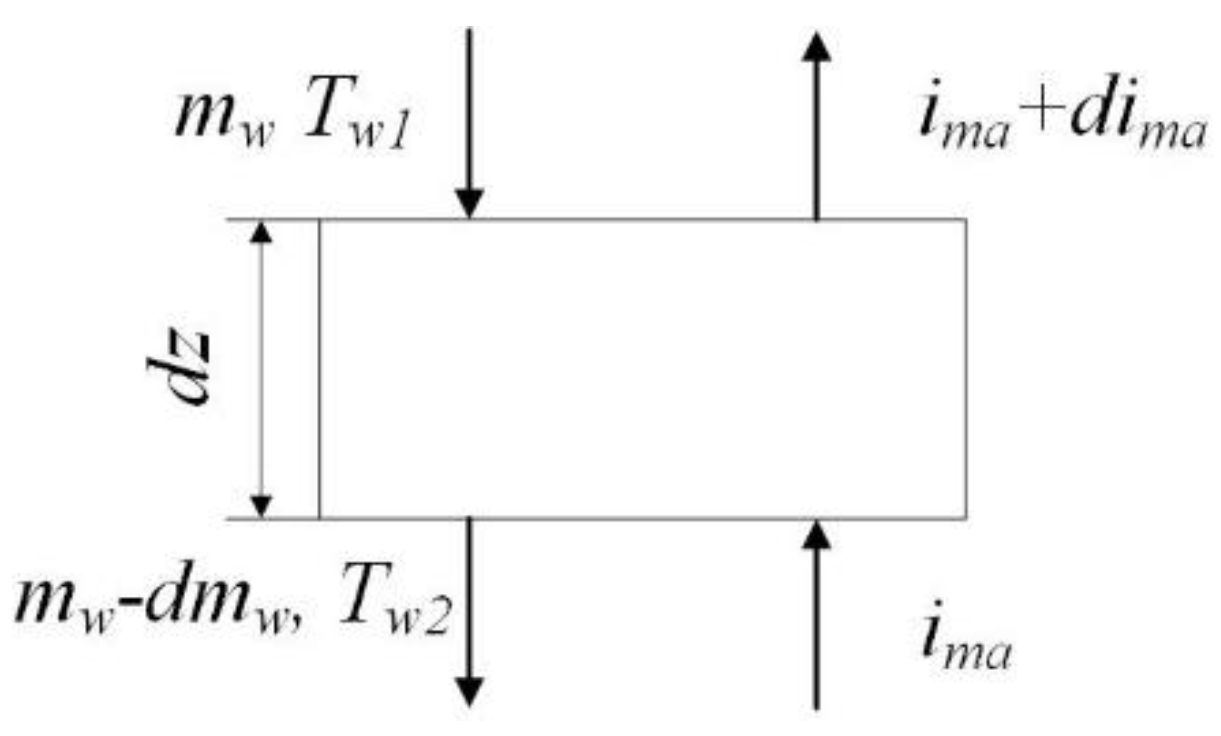
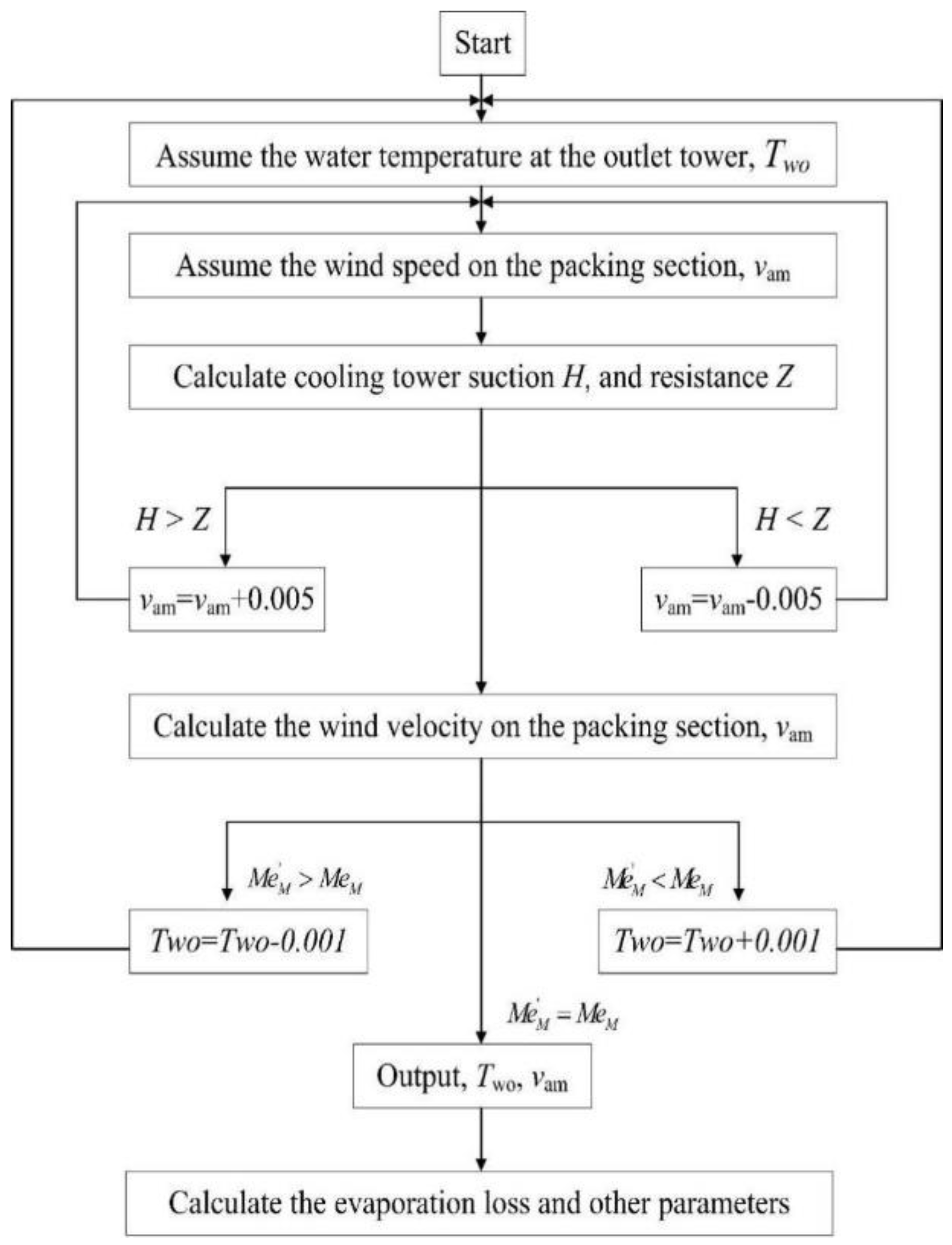

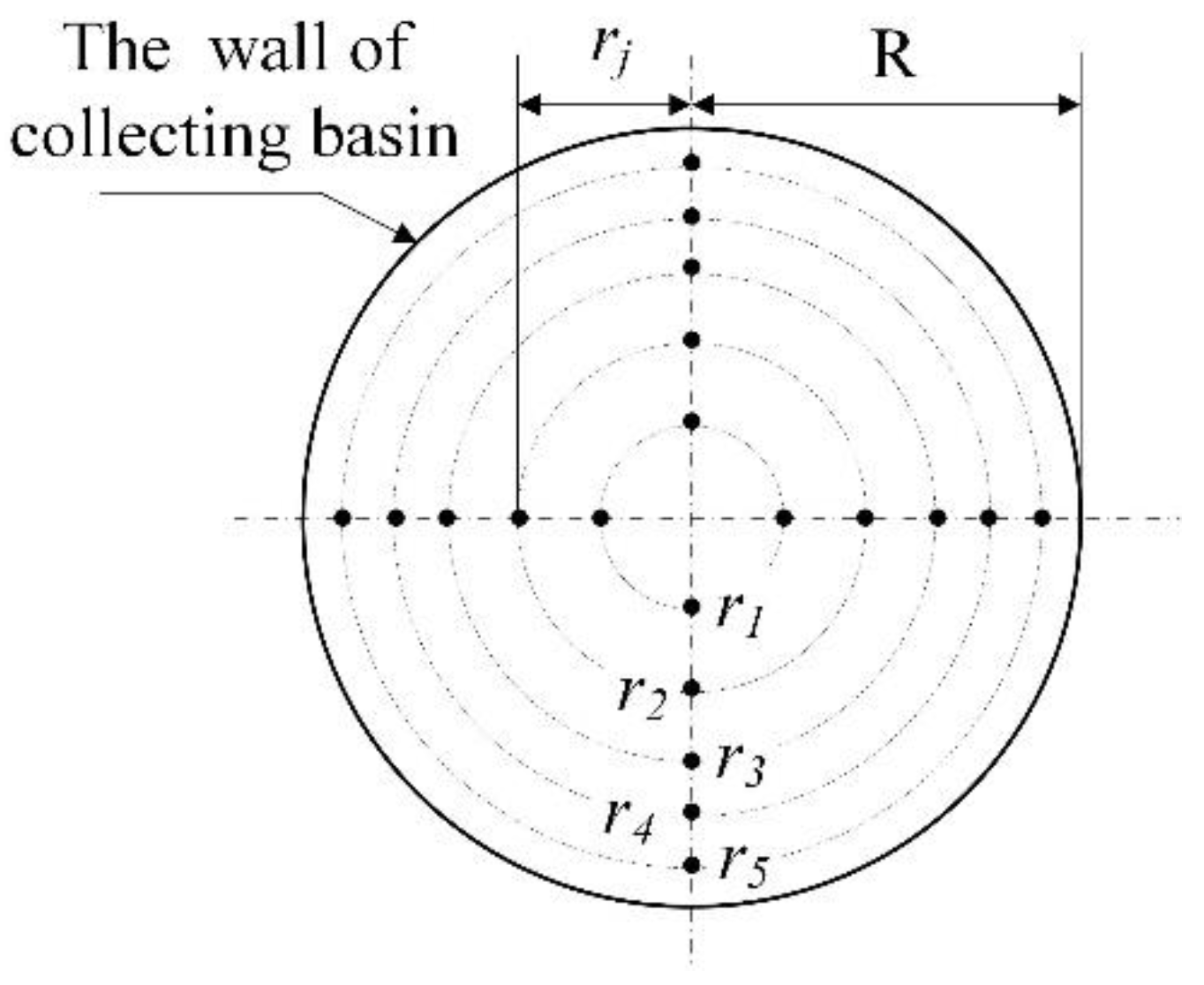


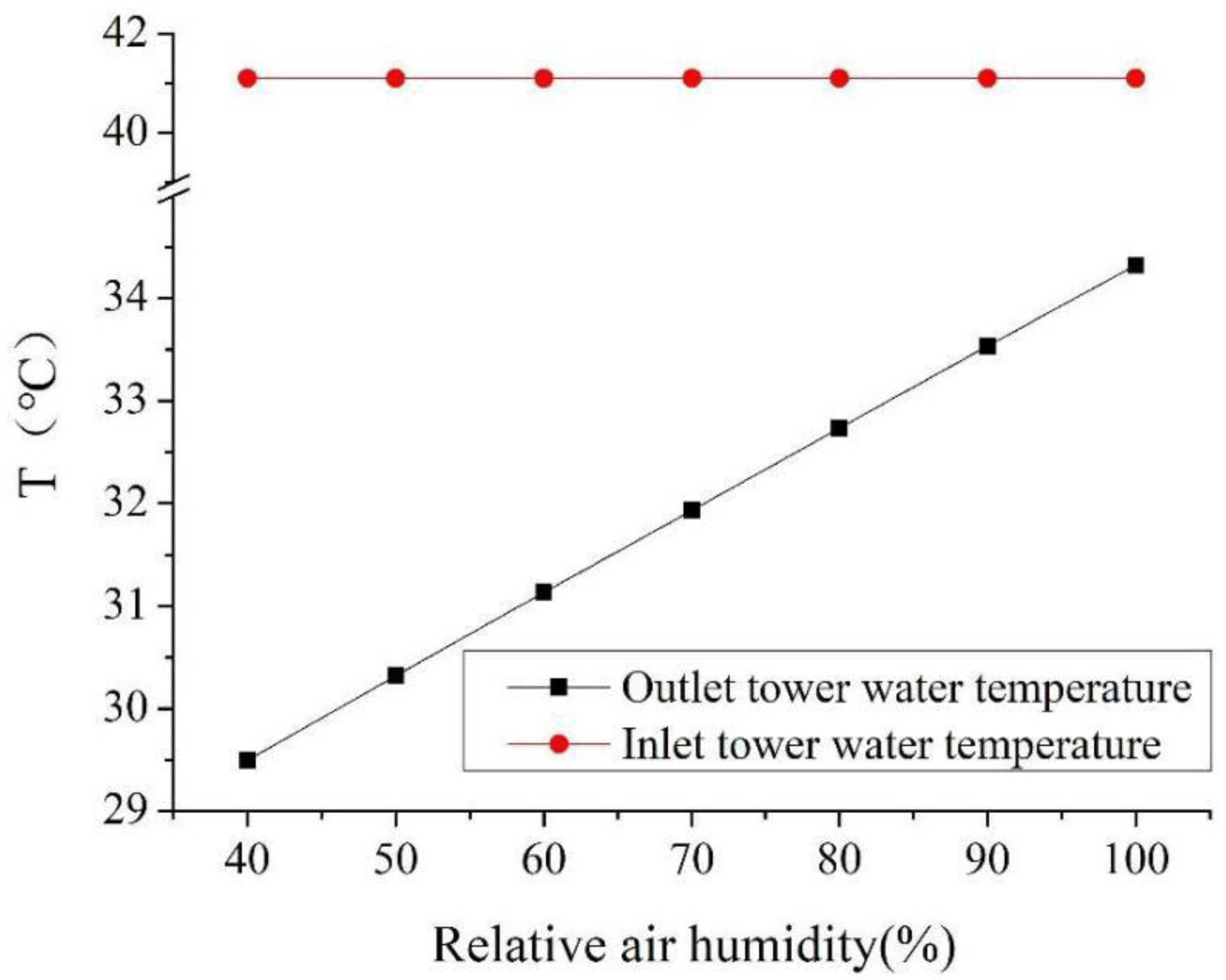


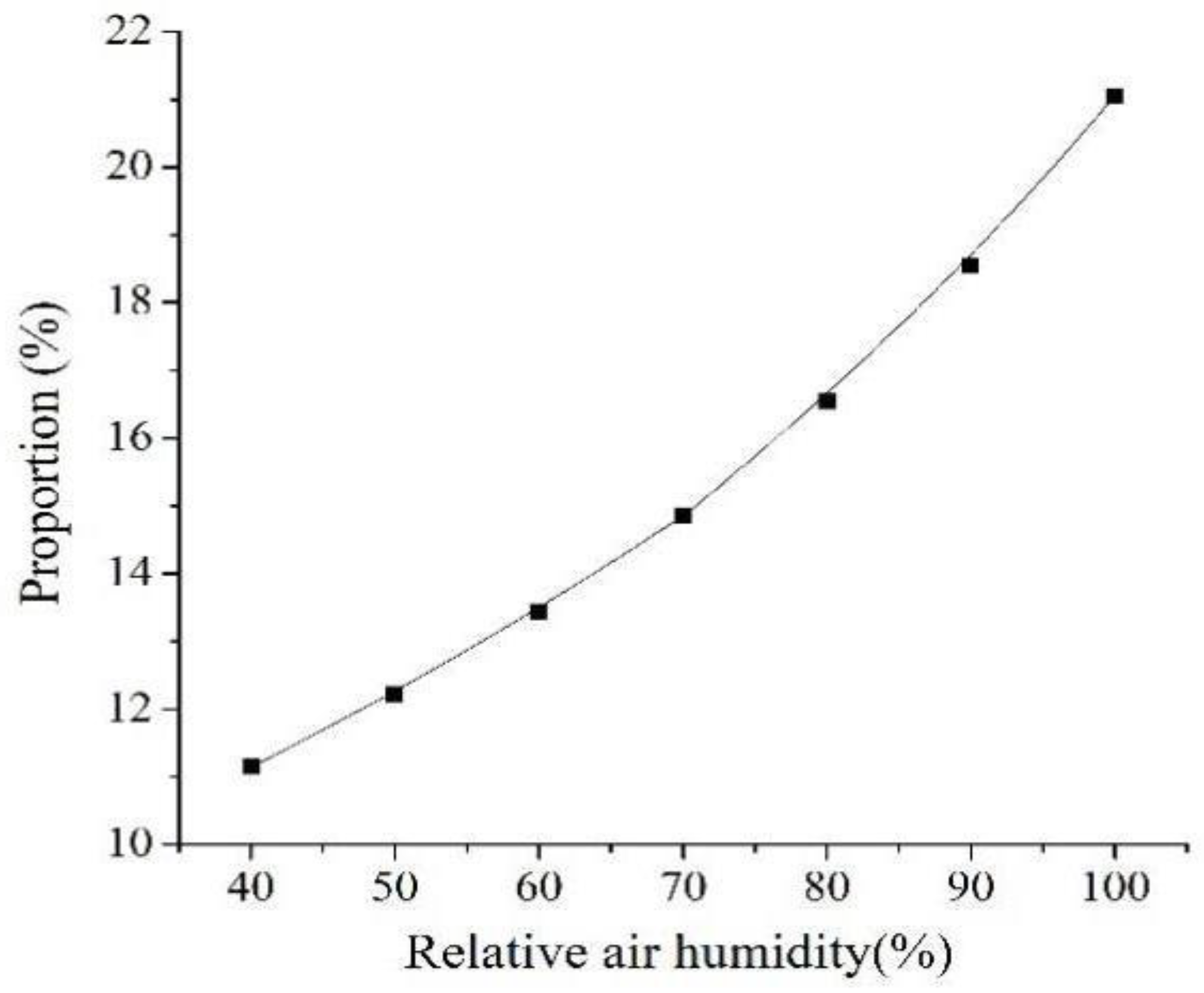

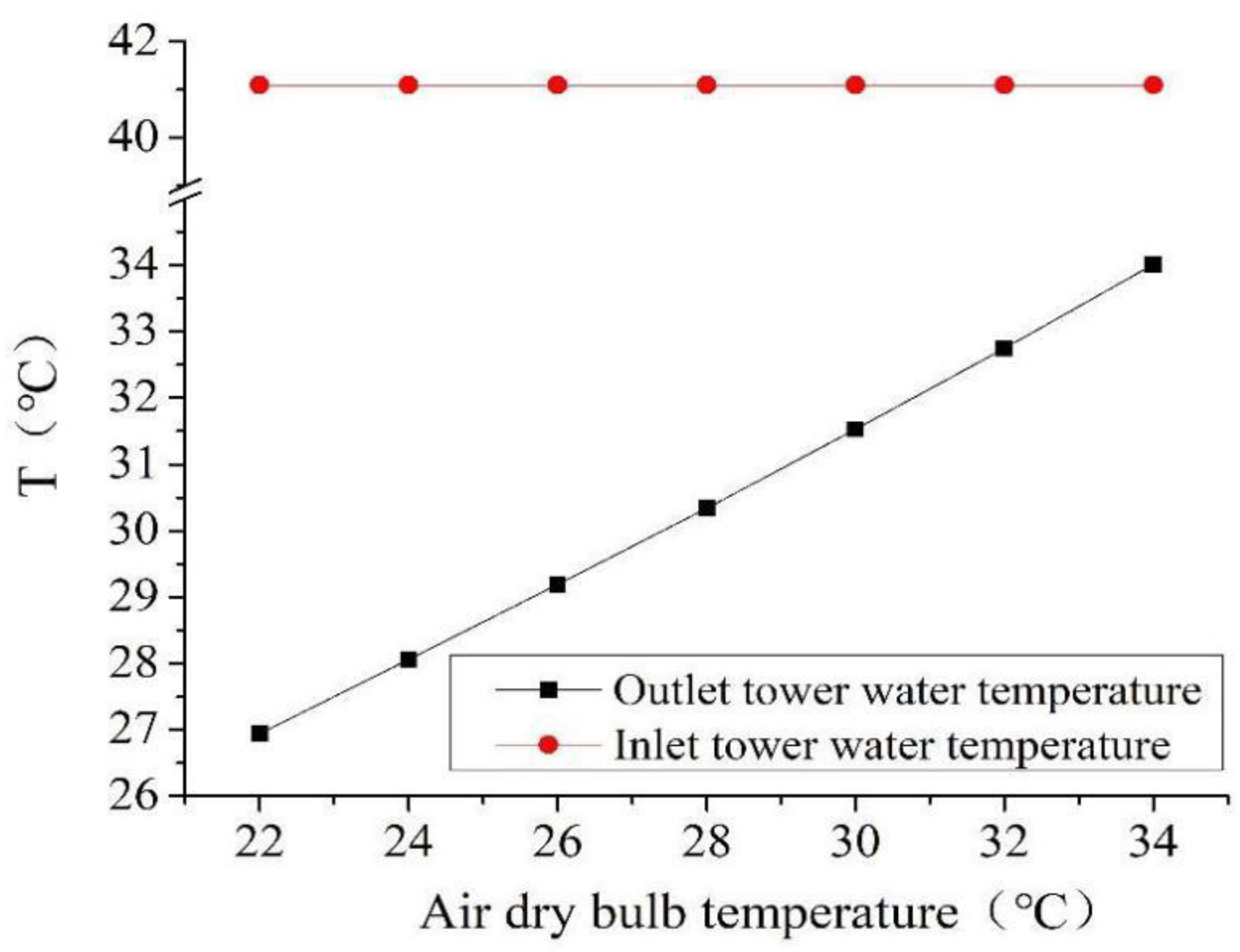
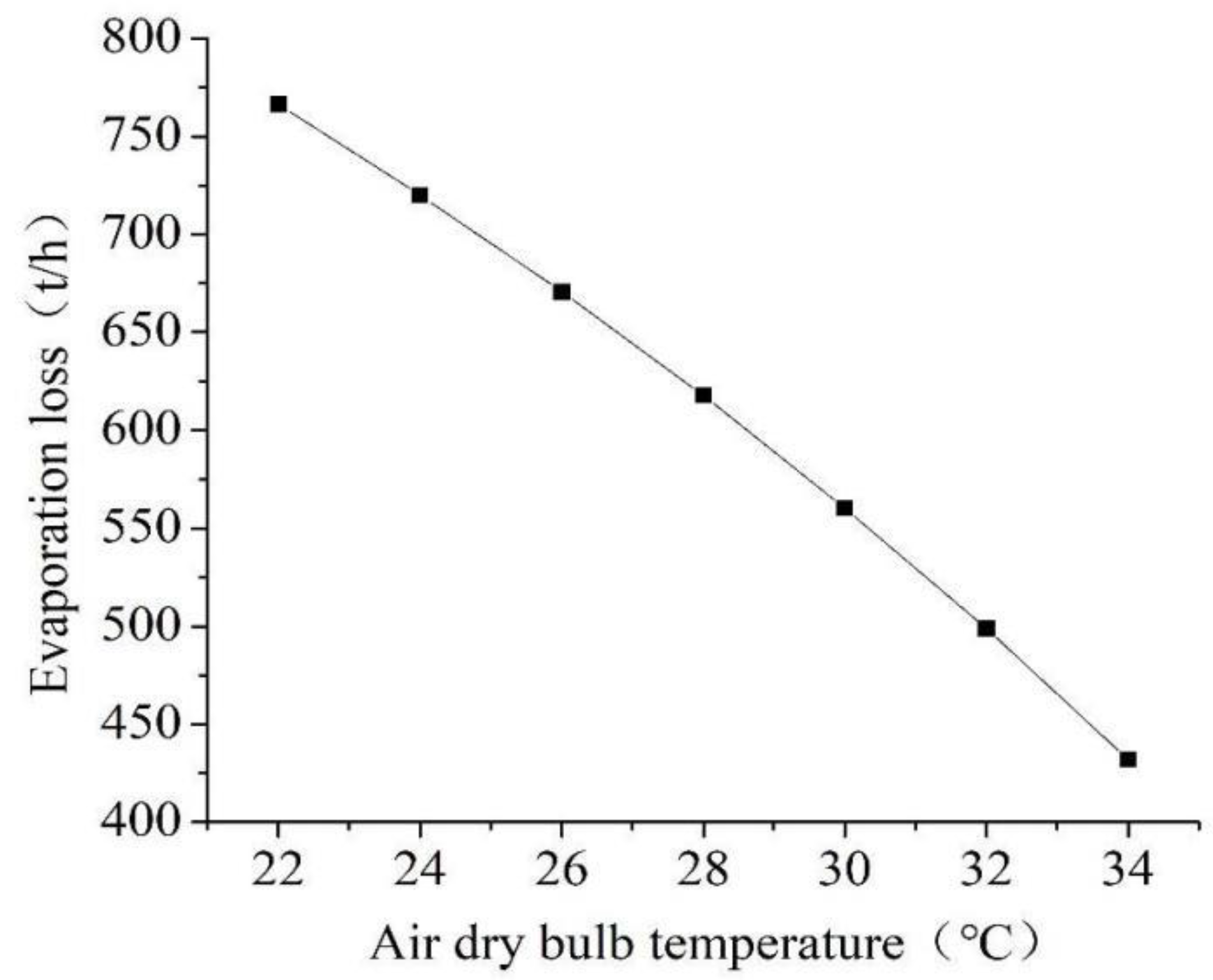

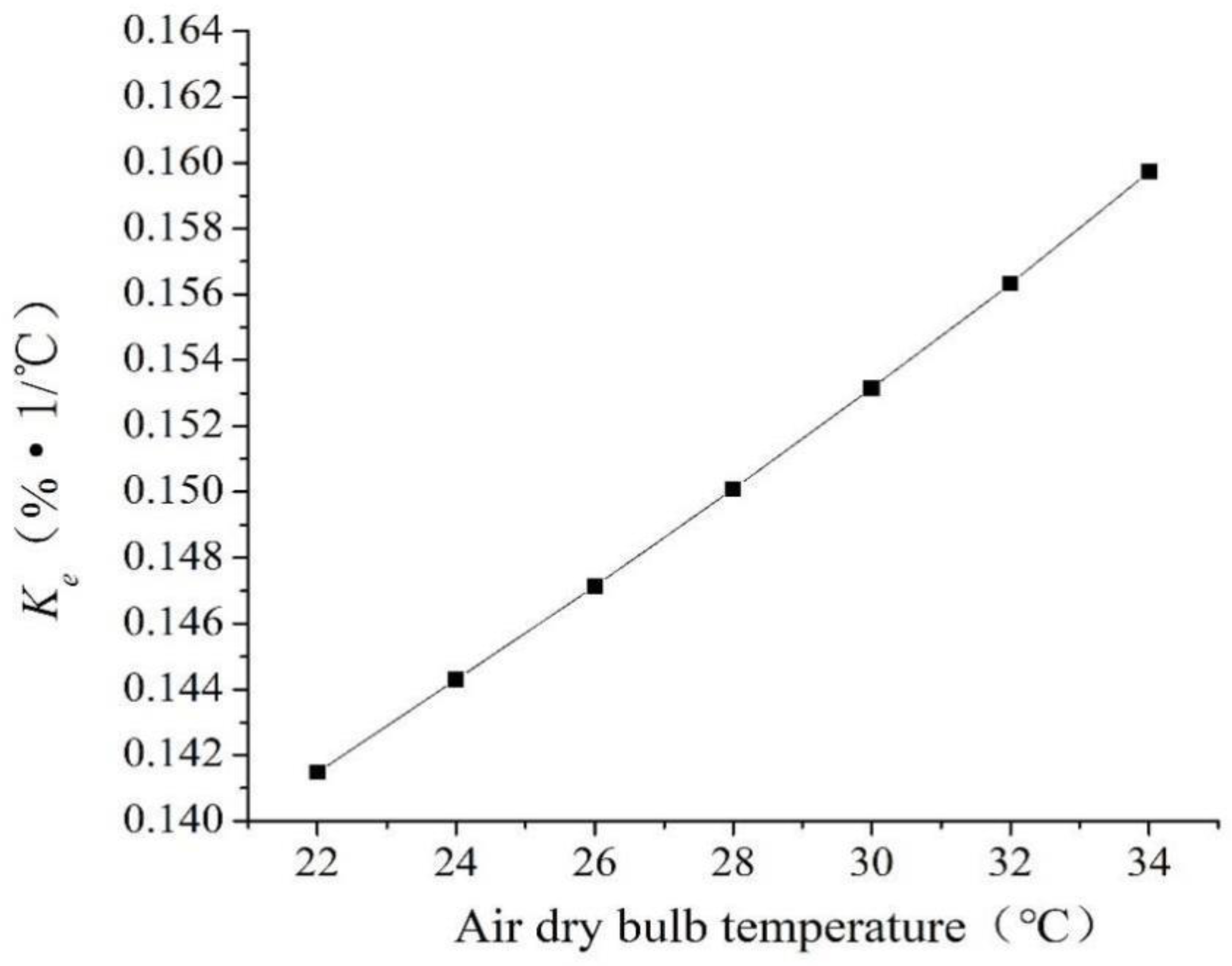
| Capacity | 300 MW | 600 MW |
|---|---|---|
| C | 1.69 | 2.19 |
| n | 0.54 | 0.65 |
| Capacity | 300 MW | 600 MW | |
|---|---|---|---|
| Geometric dimensions | Tower height (m) | 123.4 | 150.6 |
| Air inlets’ height (m) | 8.3 | 9.8 | |
| Distance between spray zone and tower outlet (m) | 113.5 | 137.6 | |
| Air inlet diameter (m) | 84.7 | 115.7 | |
| Outlet diameter (m) | 52.5 | 72.0 | |
| Area of fill zone (m2) | 5500 | 9000 | |
| Filler characteristics | Fitting formula of fillers | ||
| Item | Testing Instrument | Accuracy |
|---|---|---|
| Atmospheric pressure | Small-type meterological station | ±1.5% |
| Inlet dry and wet bulb temperature | Small-type meterological station | ±0.1 °C |
| Inlet and outlet tower water temperature | Platinum resistance thermometer | ±0.1 °C |
| Mass flow rate of circulating water | FLEXIM ultrasonic flowmeter | ±0.5% |
| Working Conditions | Meteorological Parameters | Mass Flow Rate of Circulating Water (t/h) | Inlet Tower Water Temperature (°C) | ||
|---|---|---|---|---|---|
| Atmospheric Pressure (kPa) | Dry Bulb Temperature (°C) | Wet Bulb Temperature (°C) | |||
| 1 | 99.6 | 26.5 | 19.9 | 38286 | 38.2 |
| 2 | 100.1 | 31.1 | 26.4 | 38286 | 41.4 |
| 3 | 100.8 | 26.7 | 21.0 | 22746 | 41.7 |
| 4 | 100.1 | 30.9 | 26.6 | 38286 | 41.1 |
| 5 | 100.4 | 28.6 | 23.6 | 38286 | 38.8 |
| Working Condition | Meteorological Parameters | Mass Flow Rate of Circulating Water (t/h) | Inlet Tower Water Temperature (°C) | ||
|---|---|---|---|---|---|
| Atmospheric Pressure (kPa) | Dry Bulb Temperature (°C) | Wet Bulb Temperature (°C) | |||
| 1 | 100.4 | 31.98 | 27.90 | 74272 | 41.34 |
| 2 | 101.1 | 27.52 | 25.40 | 74272 | 38.06 |
| 3 | 101.1 | 28.16 | 25.40 | 74272 | 38.49 |
| 4 | 101.1 | 27.59 | 24.21 | 74272 | 37.02 |
| 5 | 101.1 | 28.32 | 23.67 | 74272 | 38.36 |
Publisher’s Note: MDPI stays neutral with regard to jurisdictional claims in published maps and institutional affiliations. |
© 2020 by the authors. Licensee MDPI, Basel, Switzerland. This article is an open access article distributed under the terms and conditions of the Creative Commons Attribution (CC BY) license (http://creativecommons.org/licenses/by/4.0/).
Share and Cite
Yuan, W.; Sun, F.; Liu, R.; Chen, X.; Li, Y. The Effect of Air Parameters on the Evaporation Loss in a Natural Draft Counter-Flow Wet Cooling Tower. Energies 2020, 13, 6174. https://doi.org/10.3390/en13236174
Yuan W, Sun F, Liu R, Chen X, Li Y. The Effect of Air Parameters on the Evaporation Loss in a Natural Draft Counter-Flow Wet Cooling Tower. Energies. 2020; 13(23):6174. https://doi.org/10.3390/en13236174
Chicago/Turabian StyleYuan, Wei, Fengzhong Sun, Ruqing Liu, Xuehong Chen, and Ying Li. 2020. "The Effect of Air Parameters on the Evaporation Loss in a Natural Draft Counter-Flow Wet Cooling Tower" Energies 13, no. 23: 6174. https://doi.org/10.3390/en13236174
APA StyleYuan, W., Sun, F., Liu, R., Chen, X., & Li, Y. (2020). The Effect of Air Parameters on the Evaporation Loss in a Natural Draft Counter-Flow Wet Cooling Tower. Energies, 13(23), 6174. https://doi.org/10.3390/en13236174




